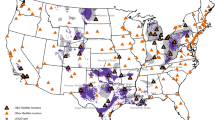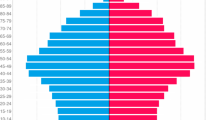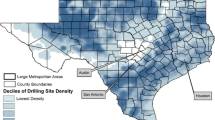Abstract
Little is known about whether exposure to unconventional oil and gas development is associated with higher mortality risks in the elderly and whether related air pollutants are exposure pathways. We studied a cohort of 15,198,496 Medicare beneficiaries (136,215,059 person-years) in all major US unconventional exploration regions from 2001 to 2015. We gathered data from records of more than 2.5 million oil and gas wells. For each beneficiary’s ZIP code of residence and year in the cohort, we calculated a proximity-based and a downwind-based pollutant exposure. We analysed the data using two methods: a Cox proportional hazards model and a difference-in-differences design. We found evidence of a statistically significant higher mortality risk associated with living in proximity to and downwind of unconventional oil and gas wells. Our results suggest that primary air pollutants sourced from unconventional oil and gas exploration can be a major exposure pathway with adverse health effects in the elderly.
This is a preview of subscription content, access via your institution
Access options
Access Nature and 54 other Nature Portfolio journals
Get Nature+, our best-value online-access subscription
$29.99 / 30 days
cancel any time
Subscribe to this journal
Receive 12 digital issues and online access to articles
$119.00 per year
only $9.92 per issue
Buy this article
- Purchase on Springer Link
- Instant access to full article PDF
Prices may be subject to local taxes which are calculated during checkout






Similar content being viewed by others
Data availability
Medicare beneficiary data are available from https://data.medicare.gov/ for researchers who meet the criteria for access to confidential data. UOGD data are available from Enverus (https://www.enverus.com/) via subscription. The UOGD exposure data that support the findings of this study are available from the corresponding author upon reasonable request.
Code availability
All model codes are available at https://github.com/longxiang1025/Fracking_Health.
References
The Distribution of US Oil and Natural Gas Wells by Production Rate (US Energy Information Administration, 2020); https://www.eia.gov/petroleum/wells/
Czolowski, E. D., Santoro, R. L., Srebotnjak, T. & Shonkoff, S. B. C. Toward consistent methodology to quantify populations in proximity to oil and gas development: a national spatial analysis and review. Environ. Health Perspect. 125, 086004 (2017).
Hydraulic Fracturing for Oil and Gas: Impacts from the Hydraulic Fracturing Water Cycle on Drinking Water Resources in the United States (Final Report) (United States Environmental Protection Agency, 2016); https://cfpub.epa.gov/ncea/hfstudy/recordisplay.cfm?deid=332990
Health Effects Institute-Energy Research Committee Human Exposure to Unconventional Oil and Gas Development: A Literature Survey for Research Planning (Draft for Public Comment) (HEI-Energy, 2019)
Adgate, J. L., Goldstein, B. D. & McKenzie, L. M. Potential public health hazards, exposures and health effects from unconventional natural gas development. Environ. Sci. Technol. 48, 8307–8320 (2014).
Garcia-Gonzales, D. A., Shonkoff, S. B. C., Hays, J. & Jerrett, M. Hazardous air pollutants associated with upstream oil and natural gas development: a critical synthesis of current peer-reviewed literature. Annu. Rev. Public Health 40, 283–304 (2019).
Shonkoff, S. B. C., Hays, J. & Finkel, M. L. Environmental public health dimensions of shale and tight gas development. Environ. Health Perspect. 122, 787–795 (2014).
Allen, D. T. Atmospheric emissions and air quality impacts from natural gas production and use. Annu. Rev. Chem. Biomol. Eng. 5, 55–75 (2014).
Cheadle, L. C. et al. Surface ozone in the Colorado northern Front Range and the influence of oil and gas development during FRAPPE/DISCOVER-AQ in summer 2014. Elementa 5, 61 (2017).
Casey, J. A. et al. Predictors of indoor radon concentrations in Pennsylvania, 1989–2013. Environ. Health Perspect. 123, 1130–1137 (2015).
Li, L. et al. Unconventional oil and gas development and ambient particle radioactivity. Nat. Commun. 11, 5002 (2020).
Hill, E. & Ma, L. Shale gas development and drinking water quality. AEA Pap. Proc. 107, 522–525 (2017).
Olmstead, S. M., Muehlenbachs, L. A., Shih, J. S., Chu, Z. & Krupnick, A. J. Shale gas development impacts on surface water quality in Pennsylvania. Proc. Natl Acad. Sci. USA 110, 4962–4967 (2013).
Blair, B. D., Brindley, S., Dinkeloo, E., McKenzie, L. M. & Adgate, J. L. Residential noise from nearby oil and gas well construction and drilling. J. Expo. Sci. Environ. Epidemiol. 28, 538–547 (2018).
Franklin, M., Chau, K., Cushing, L. J. & Johnston, J. E. Characterizing flaring from unconventional oil and gas operations in south Texas using satellite observations. Environ. Sci. Technol. 53, 2220–2228 (2019).
Casey, J. A. et al. Unconventional natural gas development and birth outcomes in Pennsylvania, USA. Epidemiology 27, 163–172 (2016).
Hill, E. L. Shale gas development and infant health: evidence from Pennsylvania. J. Health Econ. 61, 134–150 (2018).
Apergis, N., Hayat, T. & Saeed, T. Fracking and infant mortality: fresh evidence from Oklahoma. Environ. Sci. Pollut. Res. Int. 26, 32360–32367 (2019).
Currie, J., Greenstone, M. & Meckel, K. Hydraulic fracturing and infant health: new evidence from Pennsylvania. Sci. Adv. 3, e1603021 (2017).
Rasmussen, S. G. et al. Association between unconventional natural gas development in the Marcellus shale and asthma exacerbations. JAMA Intern. Med. 176, 1334–1343 (2016).
McKenzie, L. M. et al. Relationships between indicators of cardiovascular disease and intensity of oil and natural gas activity in Northeastern Colorado. Environ. Res. 170, 56–64 (2019).
Elliott, E. G. et al. Unconventional oil and gas development and risk of childhood leukemia: assessing the evidence. Sci. Total Environ. 576, 138–147 (2017).
Koehler, K. et al. Exposure assessment using secondary data sources in unconventional natural gas development and health studies. Environ. Sci. Technol. 52, 6061–6069 (2018).
Brown, D. R., Greiner, L. H., Weinberger, B. I., Walleigh, L. & Glaser, D. Assessing exposure to unconventional natural gas development: using an air pollution dispersal screening model to predict new-onset respiratory symptoms. J. Environ. Sci. Health A 54, 1357–1363 (2019).
VanderWeele, T. J. & Ding, P. Sensitivity analysis in observational research: introducing the E-value. Ann. Intern. Med. 167, 268–274 (2017).
Mathur, M. B., Ding, P., Riddell, C. A. & VanderWeele, T. J. Web site and R package for computing E-values. Epidemiology 29, e45–e47 (2018).
Giles, J. A. & Giles, D. E. A. Pre‐test estimation and testing in econometrics: recent developments. J. Econ. Surv. 7, 145–197 (1993).
Health Effects Institute-Energy Research Committee Potential Human Health Effects Associated With Unconventional Oil and Gas Development: A Systematic Review of the Epidemiology Literature (HEI-Energy, 2019).
Wing, C., Simon, K. & Bello-Gomez, R. A. Designing difference in difference studies: best practices for public health policy research. Annu. Rev. Public Health 39, 453–469 (2018).
Drilling Productivity Report (US Energy Information Administration, 2019); https://www.eia.gov/petroleum/drilling/
Research Data Assistance Center Master Beneficiary Summary File (MBSF) Base (ResDAC, 2018); https://www.resdac.org/cms-data/files/mbsf-base
Enverus Drillinginfo Direct Access Application Programming Interface. https://app.drillinginfo.com/direct/ (2019).
Doxsey-Whitfield, E. et al. Taking advantage of the improved availability of census data: a first look at the Gridded Population of the World, version 4. Pap. Appl. Geogr. 1, 226–234 (2015).
Mesinger, F. et al. North American Regional Reanalysis. Bull. Am. Meteorol. Soc. 87, 343–360 (2006).
R Core Team R: A Language and Environment for Statistical Computing (R Foundation for Statistical Computing, 2017).
Therneau, T. M. A Package for Survival Analysis in S (XXXX, 2019); https://cran.r-project.org/package=survival
Gaure, S. lfe: linear group fixed effects. R. J. 5, 104–117 (2013).
Andersen, P. K. & Gill, R. D. Cox’s regression model for counting processes: a large sample study. Ann. Stat. 10, 1100–1120 (1982).
Lee, E. W., Wei, L. J., Amato, D. A. & Leurgans, S. in Survival Analysis: State of the Art (eds Klein, J. P. & Goel P. K.) 237–247 (Springer, 1992); https://doi.org/10.1007/978-94-015-7983-4_14
Behavioral Risk Factor Surveillance System BRFSS 2013 Survey Data and Documentation (Centers for Disease Control and Prevention, 2013); https://www.cdc.gov/brfss/annual_data/annual_2013.html
Stringfellow, W. T., Camarillo, M. K., Domen, J. K. & Shonkoff, S. B. C. Comparison of chemical-use between hydraulic fracturing, acidizing, and routine oil and gas development. PLoS ONE 12, e0175344 (2017).
Di, Q. et al. Assessing PM2.5 exposures with high spatiotemporal resolution across the continental United States. Environ. Sci. Technol. 50, 4712–4721 (2016).
Earth Resources Observation and Science (EROS) Center The National Land Cover Database (United States Geological Survey, 2012); https://www.usgs.gov/centers/eros/science/national-land-cover-database
Acknowledgements
This work was made possible by support from the US Environmental Protection Agency (EPA) grant RD-835872 (L.L., A.J.B., J.D.S., B.A.C., J.L., Y.W. and P.K.), the National Institutes of Health (NIH) grant R01 MD012769 (F.D.) and the Climate Change Solutions Fund at Harvard University (F.D.). Its contents are solely the responsibility of the authors and do not necessarily represent the official view of the US EPA, NIH or Harvard University. Furthermore, the US EPA does not endorse the purchase of any commercial products or services mentioned in the publication. We sincerely thank J. M. Wolfson, J. Buonocore and L. Goodwin for editing the manuscript.
Author information
Authors and Affiliations
Contributions
P.K. and L.L. initiated the study; L.L. synthesized data and performed research; L.L., B.A.C., J.D.S. and F.D. developed the model; and L.L., F.D., A.J.B., F.J.B.-S., Y.W. and P.K. wrote the manuscript. J.L. and J.D.S. helped interpret the results and provided comments.
Corresponding author
Ethics declarations
Competing interests
F.D. has served on the HEI Research Committee. The remaining authors declare no competing interests.
Peer review
Peer review information
Nature Energy thanks Seth B. C. Shonkoff, Michael Hendryx and the other, anonymous, reviewer(s) for their contribution to the peer review of this work.
Additional information
Publisher’s note Springer Nature remains neutral with regard to jurisdictional claims in published maps and institutional affiliations.
Supplementary information
Supplementary Information
Supplementary Figs. 1–10, Notes 1–9 and Tables 1–6.
Rights and permissions
About this article
Cite this article
Li, L., Dominici, F., Blomberg, A.J. et al. Exposure to unconventional oil and gas development and all-cause mortality in Medicare beneficiaries. Nat Energy 7, 177–185 (2022). https://doi.org/10.1038/s41560-021-00970-y
Received:
Accepted:
Published:
Issue Date:
DOI: https://doi.org/10.1038/s41560-021-00970-y
This article is cited by
-
Global fossil fuel reduction pathways under different climate mitigation strategies and ambitions
Nature Communications (2023)
-
How a dangerous stew of air pollution is choking the United States
Nature (2022)
-
Assessing Exposure to Unconventional Oil and Gas Development: Strengths, Challenges, and Implications for Epidemiologic Research
Current Environmental Health Reports (2022)



